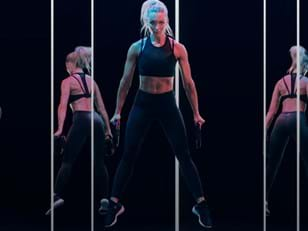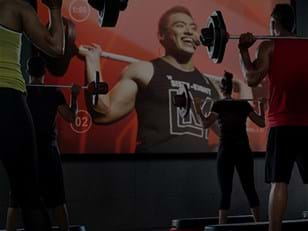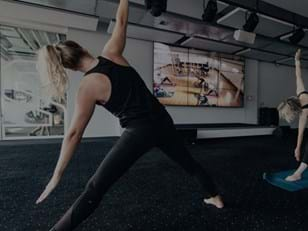Can live and virtual classes ever co-exist?
Virtual. It’s the word on everyone’s lips, with fitness experts tipping 2018 to be a breakthrough year for virtual classes. But does this mean the days of live classes are numbered? And how can clubs get the balance right?
Jak Phillips sat down with Les Mills’ Global Markets CEO Keith Burnet, to talk millennials, member habits and whether live can still thrive in the virtual age.
Does the rise of virtual fitness represent a serious threat to live classes?
Not at all, quite the opposite actually. Industry research shows live class attendances increase by an average of 12% when clubs add virtual, suggesting it actually serves as a gateway for bringing more people into live classes. Live group exercise will always be the pinnacle for clubs and for Les Mills. It’s like the music industry, people today love consuming music in a variety of different ways, but live music is more popular than ever. The best clubs will always offer live classes with great instructors. They’ll also increasingly offer virtual as it entices members with greater choice, helping to provide the ‘always-on’ service that millennials and Gen Z have come to expect.
How big is the gap in quality still between live classes and virtual?
The gap between the live and virtual experience will continue to close as the quality of content increases. That said, the current quality of virtual classes is quite poor across the industry, which is why LES MILLS Virtual is proving so popular. Experience is everything for virtual classes and you can only unlock the operational benefits – off-peak optimisation, broader timetables, more satisfied members – if you provide members with a high-quality workout. We’re entering into the next generation of virtual now and cinematic-quality content is a must if clubs are to meet members’ ever-growing expectations. Aside from content, you also need a high-quality studio to host it. Greater investment in screen set-ups, speakers, equipment and lighting will also be key to improving the virtual experience.
What will these advances mean for clubs and instructors?
Better virtual experiences will mean live class instructors will need to raise the bar and up their game to stay ahead. It’s good for everyone really, operators, instructors and members. The growth in quality virtual will also help drive up the standards of live programming to maintain its position as the premier experience. People have this perception that it’s either live or virtual, but the reality is that the most successful clubs will deploy a combination of the two. How virtual and live work together will be particularly interesting – for example, an instructor can put on a virtual class on the screen and that then frees them up to dedicate more time to coaching the class on their form and technique.
How is this impacting the way Les Mills creates virtual fitness classes?
We’re lucky that we’ve been filming our classes for decades to educate instructors on how to deliver a great class, so filming these experiences for consumers wasn’t too much of a leap into the unknown. That said, we’re constantly evolving LES MILLS Virtual and working to refine the process, so we’re learning more by pushing the boundaries, filming in different locations and improving production values to heighten the experience. Because our classes are filmed with a live audience, you have a substantial amount of atmosphere and live noise which helps to create that sense of being part of a class, rather than just looking at an instructor on a screen.
Atmosphere aside, how can you ensure virtual classes are as effective and safe as live classes?
We’ve put a lot of focus on bridging the gap between our virtual and live class offerings. This has brought innovations such as using bespoke new camera angles for virtual filming to help demonstrate the form and moves more clearly for the virtual audience. Meanwhile, the editing process is adjusted so that we give participants more time at the start of each section to change their equipment if needed and get their set-up right. In addition, we ensure the class presenters make extra effort to engage the audience, so they feel more connected.
Will the growth of virtual fitness help clubs to be more data-driven when it comes to measuring the impact of group exercise?
I certainly hope so! I strongly encourage clubs to measure group exercise attendance – many still don’t and this makes it very difficult for them to realise the value of group exercise for their business. Most of the best clubs in the world do measure group exercise and those clubs typically have over 50% of their members taking part in group exercise. At Les Mills Newmarket in New Zealand, 80% of club visits are generated through group exercise, of which 23% is from virtual classes. We know group exercisers attend more frequently and are 26% less likely to cancel their memberships than gym-only members. I think the lesson with group exercise is you get out of it what you put into it.
And finally, what else should clubs be doing to reap the benefits of offering live classes and virtual?
Combining live and virtual enables you to offer incredible social workouts and the convenience of classes on-demand, but I do think there’s a third piece of the puzzle here. Virtual means more classes are now available online, so we still see lots of home workouts as well and I think there’s a role for LES MILLS™ On Demand here to help clubs reach beyond the four walls and be more of a consistent touchpoint in their members’ lives. Clubs know that their members or prospective members are going to try some of the different online videos at home anyway, so they might as well support them with a high-quality offering that compliments what they can experience inside the club. It’s a retention tool for keeping members in the exercise habit and it can also serve as a funnel for drawing new members into the club space who have formed a love of fitness online. Today’s consumer expects to be able to access anything, anytime, anywhere and clubs need to be able to cater for this.
Keith Burnet has an extensive background in the global fitness industry, having held senior roles with David Lloyd Leisure, Living Well Health and Leisure, Hilton Worldwide and easyGym. Keith joined Les Mills as CEO of the UK business in 2012, before being promoted to COO of Global Markets in March 2015, and then CEO of Global Markets in April 2017. A proud Scotsman and passionate rugby union fan, Keith loves nothing more than spending time with his young family.
LET's TALK
HOW YOUR CLUB CAN DO IT?
LET's TALK
EMBRACE THE FUTURE
Next generation virtual represents the evolution of fitness video into a cinematic-quality format. We'll make it easy, let us calculate what virtual can do for your club. Simply give us your details and one of our team will be in touch shortly.
Error
- {{validation.errorMessage}}


